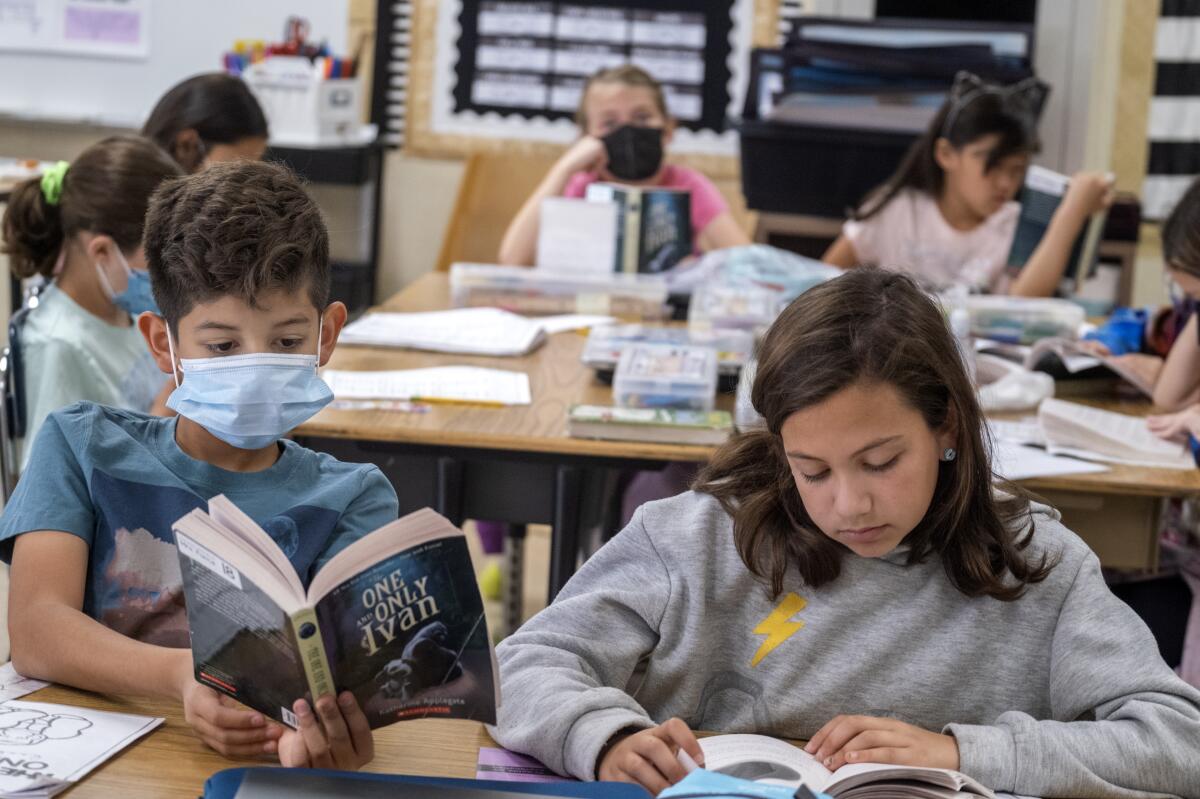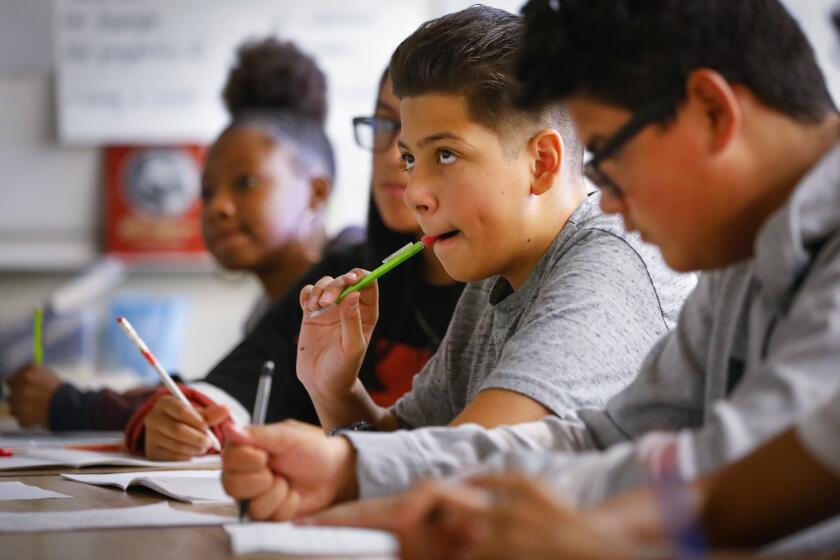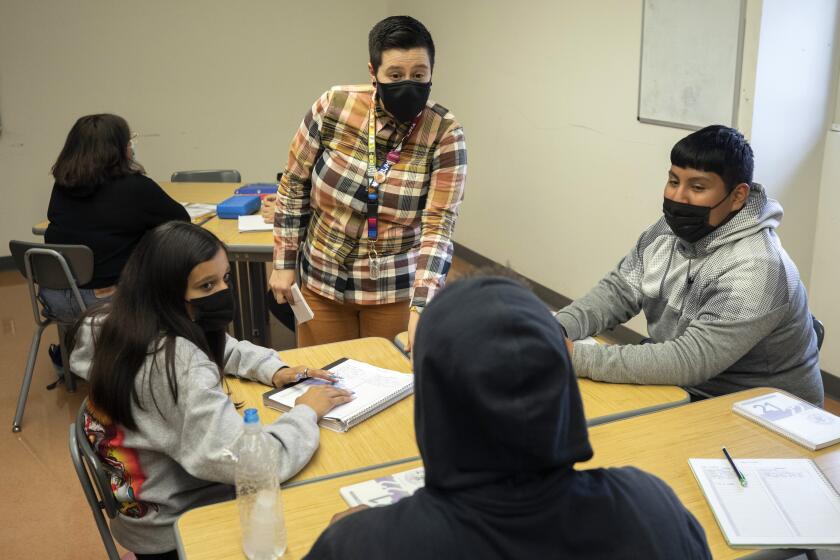California test scores show deep pandemic drops; 2 in 3 students don’t meet math standards

Two out of 3 California students did not meet state math standards and more than half did not meet English standards on state assessments taken in the spring, reflecting sizable drops in performance compared with the year before the pandemic, when large numbers of students were already struggling to meet grade-level expectations.
The test results are even more devastating for Black, Latino, low-income and other historically underserved students — 84% of Black students and 79% of Latino and low-income students did not meet state math standards in 2022.
The dismal results provide further evidence of the profound challenges facing California schools as educators focus on helping children recover from deep pandemic setbacks with multibillion-dollar investments in public education. The scores have also amplified the troubling fact that even before the pandemic, 60% of California’s students were testing below grade level in math and nearly half in English.
The state results were released just hours after the “nation’s report card” was made public Sunday night. The national assessment — which is different from the California test — also showed significant drops in math and reading scores across a majority of the country. Eighth-graders in nearly every state and fourth-graders in a large majority of states, including California, saw drops in average math scores since the pre-pandemic 2018-19 school year in what Education Secretary Miguel Cardona called “heartbreaking” academic setbacks.
Federal officials said the national test data did not show a clear linkage between the length of time schools were closed during the pandemic and achievement.
Scores on the national test for Los Angeles students, while alarmingly low, showed signs of resilience compared with other large urban districts. Sagging or stalled California scores fared slightly better than national averages but still left large percentages of students not achieving proficiency.
“The data prior to the pandemic did not reflect an education system that was on the right track,” Cardona said. “The pandemic simply made it worse. It took poor performance and dropped it down even further.”
California students struggle to meet state standards
The California Assessment of Student Performance and Progress is designed to gauge whether students are meeting grade-level standards laid out by the state Department of Education. The 2022 tests, called Smarter Balanced, show that most students are not doing so.
In both English language arts — which include writing, listening and research skills — and math, the percentage of students who did not meet expectations went up across many demographic groups compared with the year before the pandemic.
Supt. Carvalho signals that he’ll support school police in response to parents’ concerns. Student activists demand defunding.
For example, during the 2018-19 school year, about 46% of white students were not meeting state math standards. During the 2021-22 school year, 52% did not meet the standards. For Asian students, 26% were not meeting math standards before the pandemic. During the 2021-22 school year, it was 31%.
The data also show traditionally underserved students facing massive academic recovery challenges.
Sixteen percent of Black students met state standards on the math test, compared with 21% in 2019, and 30% met standards on English language arts, compared with 33% in 2019.
For Latinos, 21% met standards on the math test, compared with 28% in 2019; and 36% met standards in English language arts, compared with 41% in 2019.
“We had these wide gaps that weren’t closing before the pandemic, and now it’s just worse,” said Li Cai, a professor of education at UCLA.
“Right now we have a dire situation,” he added. “The important point is, what do we do about it? Are we just going to ignore it and pretend things are normal and proceed?”
Declines in math and reading scores on the ‘nation’s report card’ were widespread, with about one in four eighth-graders achieving proficiency in math.
State Board of Education President Linda Darling-Hammond said the data indicate that scores have been pushed back to about where they were when the state’s testing system began in 2015-16.
She noted there is now a better understanding of what works to help students catch up. Many students, with supports such as tutoring, can make up as much as a year or two in one semester, she said.
State officials were at pains to put the test scores into a broader context.
“It’s fair for people to be concerned about the experience that kids have had,” state Supt. of Public Instruction Tony Thurmond said in an interview. “But we also had 99,000 Californians who lost their lives to COVID. And we did the things that we felt we needed to do to save lives.… Now is our time to focus on how we accelerate the students’ recovery.”
Officials also pointed to what they called “hopeful signs” in the data.
An analysis by the Department of Education comparing the performance of students who took the 2020-21 English language arts and math assessments to the performance of the same students in 2022 “showed steeper-than-normal achievement gains at most grade levels,” state officials said in an interpretation guide presented along with the results.
Thurmond highlighted recent investments by the state, including efforts to recruit 10,000 more counselors and $4 billion for “community schools” — which are intended to provide wide-ranging help for what students and families need.
California’s bold plan dramatically expands the traditional definition of a public school, overhauling campuses into neighborhood centers to meet the needs of students.
The state also has a phased-in plan to add a year of instruction by allowing all 4-year-olds to enroll in public school and it is providing $250 million for literacy, money that can pay for reading coaches and other specialists. Thurmond pointed to tutoring programs, longer school days and longer school years as methods that have been well documented to help accelerate student learning.
Money is available for such efforts in the short to medium term, but districts have had trouble hiring needed staff and carrying out recovery plans. L.A. Unified has had difficulty getting tutoring services to students and has been unable to overcome resistance to an extended school year.
Alicia Montgomery, executive director of the L.A.-based Center for Powerful Public Schools, which manages student enrichment programs and supports school-based improvement efforts, called on officials to act with urgency to support students that are struggling the most.
“Unless we’re willing to do that, we’re always going to have our most vulnerable populations not getting what they need to be successful not just in school, but in life,” she said. “After students graduate from high school, these data points show up in our unemployment rates. They show up in our health disparities.”
The ‘nation’s report card’ shows big drops
The national tests — given to a sample of fourth- and eighth-graders in early 2022 — measure how well students across the country are doing in reading and math based on frameworks developed by the National Assessment Governing Board. Those tests allow for comparisons across states.
Across the country, only about 1 in 4 eighth-graders met standards for proficiency on the national math assessment, down from about 1 in 3 in 2019.
In reading, about 31% of eighth-graders met standards for proficiency, down from about 34% in 2019.
“We have a whole generation of students whose academic careers were knocked off track,” said Peggy Carr, commissioner of the National Center for Education Statistics. “So parents need to know this is a serious issue here. This is not to be taken lightly.... And it’s not good just to go back to normal because normal wasn’t good for some of us, was it?”
The national test results were less dire for California than some experts had feared. Scores dropped in math but held steady in reading. Still, they do not reflect strong student performance. Before the pandemic, the state was underperforming compared with national averages in reading and math.
And the results of the national test mean that only about 30% of California eighth-graders achieved proficiency in reading. About 23% achieved proficiency in math.
California’s bold plan dramatically expands the traditional definition of a public school, overhauling campuses into neighborhood centers to meet the needs of students.
Nationwide the drop in math scores was especially steep and widespread, particularly for eighth-graders, a year that is a crucial steppingstone for higher-level math. In California, where the vast majority of schools were closed until spring 2021, scores fell by 6 points. In Texas and Florida — where schools opened sooner — scores fell by 7 points, and in Oklahoma, where schools also started earlier, they fell by 13 points.
Carr said the National Assessment of Educational Progress results do not provide clear-cut answers about how time spent in virtual classes affected student performance.
“There’s nothing in this data that says we can draw a straight line between the time spent in remote learning, in and of itself, and student achievement,” she said.
Keri Rodrigues, president of the advocacy organization the National Parents Union, said she wants officials across the country to focus on solutions rather than blame.
“This is a moment where our kids are in crisis and what we don’t need is the political bickering and back and forth,” she said. “We don’t have time to lose while our kids are literally falling through the cracks.”
More to Read
Sign up for Essential California
The most important California stories and recommendations in your inbox every morning.
You may occasionally receive promotional content from the Los Angeles Times.















